Lake Updates
What About Radon Gas at the Lake??
2018 Muskie legislation information
Hydraulic Jet info
2018 Dock Info
Muskie article written in 2010 summarizing concerns
This 2010 article exemplifies that the muskie
issue is not new and does a good job of laying out the points that are
confronting us today.
Go here to read the full article.
Ottertail COLA seminar on Lake/Lakeshore Issues and Plants
On May 23rd, from noon to 4:30pm, there
will a seminar on these topics as well as exhibits and a question and answer
period featuring Moriya Rufer, along with Gabe Dretsch (SWCD), Craig Johnson
(Landscape Architect) and Darby Nelson (guest speaker). For more info,
GO HERE.Muskie Stocking and Length Increase by MNDNR
As property owners we are all very aware of the value of our
resource, and our need to share with the public. While only about 1/3
of our resident population fish, the resource of fishing and the value of a
good fishing lake is very important to all of us. There is an effort by a
small group of fisherman, along with the MNDNR, to continue to stock muskie
in our lake. The muskie fisherman are reported to purchase about 14%
of the fishing licenses in Minnesota, and are trophy fisherman only, they do
not fish to put food on the table, their goal is the thrill of catching a
“trophy class” fish. While we have no objection to the muskie
fishermans’ sport, we do object when we believe it is having a negative
effect on the majority of sport fishing on Pelican Group of Lakes.
2014 Lake and Stream Monitoring Accessment
Moriya Rufer has completed the analyzation of the PGOLID lake and stream monitoring for 2014. The trends are either holding steady or improving and at least some of that can be credited to education programs over the years and PLPOA member efforts. The Lake Summary can be found HERE and the Stream Summary can be found HERE. More detailed information can be found under the program link on the PGOLID website.
Bur Oak Blight Alert
Some around the lake have discovered Bur Oak Blight on their oak trees. It visually appears in the latter part of summer and seems to be coming more prevalent around the lake. The visual signs are dying of the leaves in the lower portion of the tree. If you happen to be around the lake in late fall and into the winter, you’ll notice that many of those dead leaves don’t fall off the tree. Currently, the only way to reduce the problem it injecting a systemic fungicide into the tree in early June at a cost in the neighborhood of $400 per tree. Here are a few sites with more information
Bur Oak Pest Alert University of Iowa seminar
PGOLID Zebra Mussel Monitoring
This year, PGOLID is monitoring the densities and
distribution of adult Zebra mussels in the lakes. Zebra
mussel sampler plates will be placed at three locations in Pelican Lake, and
one location in each of Fish, Bass and Little Pelican Lakes.
These sampler plates will be examined monthly, and the adult Zebra
mussels will be counted. This study will tell us where
the Zebra mussels are distributed in the lake and where they are most dense.
This information will be shared with the DNR and Zebra mussel
researchers. For more information, you can contact Moriya
Rufer, 218-846-1465, moriyar@rmbel.info
It’s time to separate Fact from Fiction regarding Zebra Mussels
Although PGOLID and PLPOA are at the forefront of
education on how to maintain the quality of our lake as well as preventing
the spread of AIS (Aquatic Invasive Species), we choose not to do that with
scare tactics that aren’t true, so here are some facts to dispel some of the
rumors floating around out there. Zebra mussels were
discovered on Pelican Lake in 2009 and some of those found were determined
to be one or two years old because of their size. Zebra
mussels have a 3 to 4 year life cycle in our area and go dormant at less
than 55 degrees. They cannot survive freezing
temperatures.
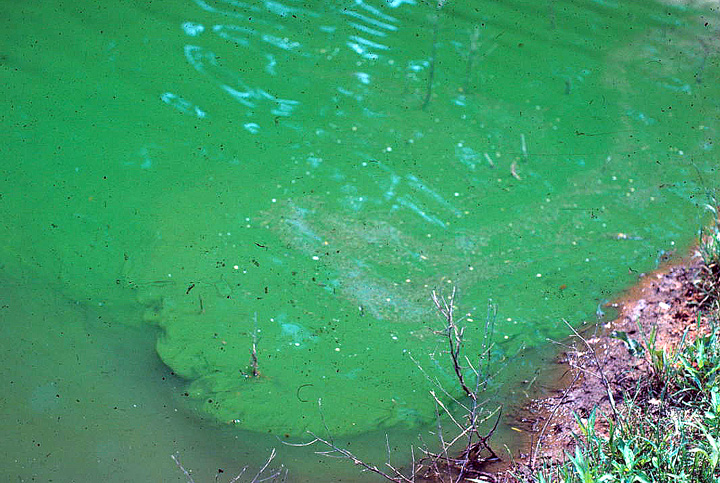 Potential
for Blue-Green Algae with this Summer's heat
Potential
for Blue-Green Algae with this Summer's heat
Minnesota's extended stretch of hot weather has prompted a warning about
toxic blue-green algae.The algae gathers on the surface of the water and is
known to kill dogs if they drink enough of it. It can also cause rashes and
respiratory problems for people.
Pam Anderson of the Minnesota Pollution Control Agency said people should
be aware of the potential for trouble, and make sure kids and pets stay out
of water that looks doubtful.
This year's water clarity is running at record highs
Many people have noticed how clear the water is this year and assume it's all about the zebra mussels. Moriya Rufer has done some mid-season analysis on this and while a portion of it can be contributed to that effect, it is more involved than that. Click HERE to get a better understanding. Take note that this is the 1st year we've ever checked the water clarity on April 1.
Low Interest Septic System Loans
Fortunately, most of the septic systems in need of attention have been upgraded, but it you happen to be one that needs to have work done, the MN Department of Agriculture has low interest (3%) mony available under the AgBMP program. Interested people can contact Deb Werner at Ottertail Soil and Water Conservaton District in Perham (218) 346-4260.
DNR continues to revise AIS Regulations
5/22/12 The DNR continues to make changes
to the Aquatic Invasive Species regulations. Some have been added and
then removed. They can’t make up their mind on what constitutes
riparian (interface between land and a lake) so they
decided to define it differently depending on whether you are a business or
an
individual. Their logic was that they didn’t know where
to draw the line, even though all service providers are trained and the DNR
has a permit system in place to track where equipment is stored.
Click here to see the latest regulations, but assume it will change
again
shortly.
The Myths and Hysteria surrounding Zebra Mussels
By Jeff Peltier
There is a lot of Hysteria floating around regarding Zebra Mussels and the damage they can cause, so let’s review some of the concerns.
Zebra mussels will destroy docks and lifts.
While they will attach to objects and as they become more populated even plants and other clams or shells, they do not eat metal or plastic. We are fortunate that in our climate the lakes freeze over and people take their docks and lifts out. The Zebra mussels die when out of the water or at temperatures below freezing. If you would like to remove them from your lifts and docks and want to do it at a minimum effort, I would wait until spring after the mussels are dead and have freeze-dried a few times. It’s much easier than trying to remove them right after removal from the water. Continued
For more information on Zequanox (one of the Biocides that specificly controlls Zebra Mussels), check out this presentation by Dr/Salesman Daniel Molloy
HELP PREVENT THE SPREAD OF ZEBRA MUSSELS FROM PELICAN TO OTHER AREA LAKES
 Zebra mussels were found in Pelican Lake in September, 2009. Zebra mussels are an invasive species that has been spread throughout Minnesota Lakes , including Mille Lacs and the Alexandria area lakes. Zebra mussels are ¼ to 1 ½ inches long and are D-shaped with alternating black and brown stripes. Zebra mussels are tricky to find when they are larvae, because they are not visible to the naked eye. The larvae can live in your live well if there is water there, or in your minnow bucket and then spread into other lakes. Zebra mussels can attach to hard surfaces such as boat lifts and docks and clog water intake pipes.
Zebra mussels were found in Pelican Lake in September, 2009. Zebra mussels are an invasive species that has been spread throughout Minnesota Lakes , including Mille Lacs and the Alexandria area lakes. Zebra mussels are ¼ to 1 ½ inches long and are D-shaped with alternating black and brown stripes. Zebra mussels are tricky to find when they are larvae, because they are not visible to the naked eye. The larvae can live in your live well if there is water there, or in your minnow bucket and then spread into other lakes. Zebra mussels can attach to hard surfaces such as boat lifts and docks and clog water intake pipes.
At this time there is no treatment for zebra mussels; however, research projects are in progress and we are hopeful that in the future a treatment will be available. Until then, it is imperative to prevent spread to other lakes so that the problem remains contained.
AVOID THE SPREAD
Please take the following steps to prevent the transport of zebra mussels and other aquatic invasive species to new waters:
- Inspect and remove aquatic plants, animals, and mud from your boat, trailer, and equipment.
- Drain all water from your motor, livewell, bilge, transom, etc.
- Dispose of unused bait in the trash.
- Wash your boat and equipment with hot and/or high pressure water, particularly if moored for more than one day, OR
- Dry your boat and equipment thoroughly (in the sun) for five days.
PROTECT YOUR BOAT
Is your boat protected against zebra mussels? Unfortunately, some boat owners are seeing and feeling the damage caused by zebra mussels first hand. Their boat hulls are being damaged and their motors are overheating because they do not know how to minimize the impacts zebra mussels can cause.
- Use a boatlift to completely remove the watercraft from the water.
- Use your boat (run the engine) at least twice a week at slow speeds (4 mph) for 10-15 minutes. The hot water will kill the zebra mussels in your engine’s cooling systems.
- Lift motor out of the water between uses if mooring.
- Tip down the motor and discharge the water when leaving a water body.
- Rinse your boat and equipment if you leave Pelican Lake and intend to visit another lake.
- Apply antifouling paints to the hull and the engine’s cooling system. In-line strainers can also be installed in some cooling systems.
- Apply protective paint to your boat’s hull. (See below)
Bottom Paints that work in Fresh water
For those trying to protect aluminum boats, lifts, docks, etc from Zebra Mussels, note that it is important to know which paints can be used. Here are some guide lines.
Aluminum hulls, outdrives and props require paints such as Vivid, Trilux 33, Trilux Prop and Drive Paint and Alumaspray that do not contain cuprous oxide, which reacts destructively with the aluminum. Copper-based paints are safe for use on properly primed stainless and bronze. Zinc anodes should be left unpainted to retain their effectiveness.
For fiberglass boats, there is a different selection of paints that do well in fresh water and here are a few:
Pettit Super Premium, Pettit Hydrocoat and Interlux Ultra are high in copper and quite effective. Slick racing paints like Pettit SR-21 and Interlux VC-17M are lower in copper, but still hold up well in Lake Erie. Interlux Bottomkote Aqua is a good water-based hard paint.
2010 Lake Management Data is now on-line
All the 2010 data has been compiled and is now on-line. The data is easily searchable to fined what you might be looking for. Click here to view the data.
2010 Access Inspection report is now in
It took a little longer to get the report from the DNR this year, but the information is now in. There were 1483 inspections done over a period of 746 hours. Even though there were more hours at the east access than the west access, more boats were inspected at the west access which would indicate that access is more active. About half the boats inspected were out of state with the vast majority being ND. To read the full report, click here.
New Regulations on transport of water
As of July 1, 2010, the following regulations, apply to the transportation of water by boaters from all waters in the state (violations are misdemeanors):
- a person leaving waters of the state must drain boating-related equipment holding water and live wells and bilges by removing the drain plug before transporting the watercraft and associated equipment on public roads; and
- drain plugs, bailers, valves, or other devices used to control the draining of water from ballast tanks, bilges, and live wells must be removed or opened while transporting watercraft on a public road (marine sanitary systems and portable bait containers are excluded from this requirement).
Forest Tent Caterpillar Alert 5/29/10
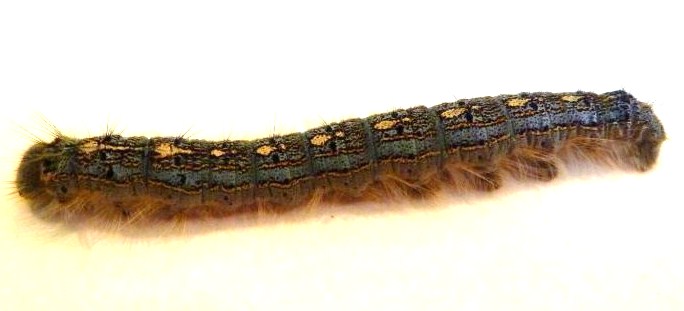
If you have any questions, contact Gary Hart gdkihart@loretel.net 532-3613 or Jeff Peltier peltier@plyc.info 532-3388.
Update on Zebra Mussels on Pelican Lake
We now have some better information on how to deal with zebra mussels and what rules and regulations effect us on Pelican Lake. CLICK HERE to read that information.
Protect your boat and engine from zebra mussels
Is your boat protected against zebra mussels? Do you know what to do? Unfortunately, some boat owners are seeing and feeling the damage caused by zebra mussels first hand. Their boat hulls are being damaged and their motors are overheating because they do not know how to minimize the impacts zebra mussels can cause. These small invasive mussels attach to hard surfaces including boats and motors! There are simple and proactive steps owners may implement to protect their investment and prevent the spread of invasive species into more of Wisconsin’s waters. READ MORE
DNR Landing Inspection Report
The 2009 DNR landing inspection report is complete. These landing inspections are co-sponsored by PGOLID and the MN DNR in an effort to increase awareness of invasive species and how to deal with them. To read the details, CLICK HERE.
 Zebra Mussels
Zebra Mussels
We regret to inform you that zebra mussels have been found in Pelican Lake . This was confirmed Monday, September 14 by the Department of Natural Resources (DNR).
Zebra mussels are an invasive species that has been spread throughout Minnesota Lakes , including Mille Lacs and the Alexandria area lakes. Zebra mussels are ¼ to 1 ½ inches long and are D-shaped with alternating black and brown stripes. Zebra mussels are tricky to find when they are larvae, because they are not visible to the naked eye. The larvae can live in your live well if there is water there, and then spread into other lakes. This could be how they entered Pelican Lake . Zebra mussels can attach to hard surfaces such as boat lifts and docks and clog water intake pipes.
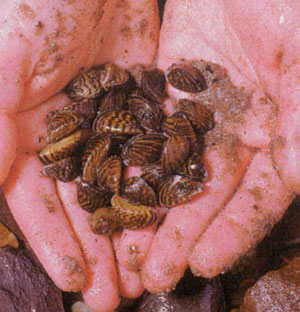 Please help us in looking for zebra mussels as you remove your dock and boat lift for the winter. Contact Moriya Rufer, PGOLID Water Resource Coordinator, 218-846-1465, if you find any stuck to your dock and lift so she can track them on a map of the lake. We want to monitor their spread throughout the lake. You can see a photo of zebra mussels below.
Please help us in looking for zebra mussels as you remove your dock and boat lift for the winter. Contact Moriya Rufer, PGOLID Water Resource Coordinator, 218-846-1465, if you find any stuck to your dock and lift so she can track them on a map of the lake. We want to monitor their spread throughout the lake. You can see a photo of zebra mussels below.
Unfortunately, there is no remedy for Zebra mussels. There is no chemical treatment available to control them. The best we can do is monitor their spread.
There are some new regulations that apply to Pelican Lake now that it contains zebra mussels (http://www.dnr.state.mn.us/eco/invasives/laws.html)
- taking wild animals (fish, frogs, crayfish, etc.) from infested waters for bait or aquatic farms is prohibited;
- equipment used for commercial fishing purposes in infested waters must be dried or frozen before it can be used in noninfested waters (misdemeanor);
- water from infested waters may not be used to transport fish except by permit;
- persons leaving infested waters that contain populations of spiny waterflea or zebra mussels must drain bait containers, other boating-related equipment (excluding marine sanitary systems) that holds water, and livewells and bilges by removing the drain plug before transporting the watercraft and associated equipment on public roads ($50 civil penalty or misdemeanor);
- water from infested waters may not be transported on a public road or off riparian property on infested waters except in emergencies or under permit ($200 civil penalty or misdemeanor).
More detailed information will follow as we learn more about the infestation.
To read more about Zebra mussels, please visit the following links:
http://www.dnr.state.mn.us/invasives/aquaticanimals/zebramussel/index.html
http://www.seagrant.umn.edu/ais/zebramussel
Zebra mussels are ¼ to 1 ½ inches long and are D-shaped with alternating black and brown stripes.
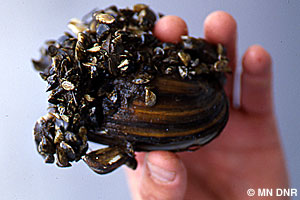
Ottertail County inspected septic systems 20 years old or more on Pelican Lake over the last 3 years. 7/31/09 The results are below.
Total lake systems listed - 981 |
|
|
Total Inspected systems |
329 |
33.5% |
Illegal Cesspools |
23 |
|
Illegal Cesspool in groundwater table |
1 |
|
Illegal Cesspool with open pipe discharge |
1 |
|
Holding tanks with broken bottoms |
4 |
|
| Holding Tank with Illegal outlet | 1 | |
| Block tanks or wooden crib tanks | 4 | |
Illegal sink or shower drains |
10 |
|
| Tanks too close to wells | 2 | |
No apparent risers |
23 |
|
Paved over drain field |
8 |
|
Illegal Outhouses or Dump stations |
4 |
|
| Illegal washing machine drain | 1 | |
| Illegal outdoor shower | 1 | |
Systems not updated after site permits |
3 |
|
Total abated systems |
86 |
|
|
||
% of inspected systems abated |
26.1% |
|
% of total lake systems abated |
8.8% |
|
Bob Creek E.coli concerns 6/26/09
As a follow up on our concerns from last year, the E.coli levels continue to be a concern after rain events a Bob Creek. The early indications are that it is trending a little lower than last year, but after rain events, the levels are above the standard of 126 organisms per 100 milliliters. For example on June 17th for a 6 hour period, the levels were above 200 and then on the 18th the levels were back at safe levels. At this point, we would recommend not swimming in or within 2 cabins of Bob Creek within 24 hours following a rain event. If you have any questions, contact Moriya Rufer at (218) 846-1465 or Jeff Peltier (218) 532-3388
Aquatic plant removal may require permits - 05/29/2009
Lakeshore property owners are reminded that many aquatic plant management activities require a permit from the Department of Natural Resources (DNR).
Lakeshore property owners can control a modest area of aquatic plants for swimming or boat docking without a permit from the DNR. Cutting, pulling, raking, or harvesting submersed vegetation, like pondweeds, watermilfoil, or coontail, in an area for recreation is allowed under the following conditions:
• The cleared area may not exceed 2,500 square feet in size.
• The cleared area may not extend more than 50 feet along your shore, or more than one half your frontage width, whichever is less.
• If the cleared area does not reach open water, a 15-foot wide channel to open water may be added.
• The cut or pulled vegetation must be removed from the water. If floating leaf vegetation, like white or yellow water-lilies interfere with boat access a lake shore property owner can mechanically maintain a channel no more than 15 feet wide, extending to open water without a permit, under the following conditions:
• The cleared channel must remain in the same place from year to year.
• And the vegetation that is cut or pulled must be removed from the water.
A DNR aquatic plant management permit is required if your plans include the following:
• Using herbicides or algicides.
• Removing emergent vegetation, like bulrush, cattails or wild rice.
• Installing or operating an automated plant control device.
• Removing floating leaf vegetation, in an area larger than a 15 foot wide channel.
• Controlling submerged vegetation in an area larger than 2,500 square feet or wider than 50 feet. • Removing or relocating a bog of any size.
The DNR aquatic plant management regulations do not allow the following activities:
• Excavating the lake bottom for aquatic plant control.
• Use of hydraulic jets.
• Using lake-bottom barriers to destroy or prevent the growth of aquatic plants.
• Removing aquatic vegetation within posted fish-spawning areas.
• Removing aquatic plants from an undeveloped shoreline.
Pelican Lake Dam update
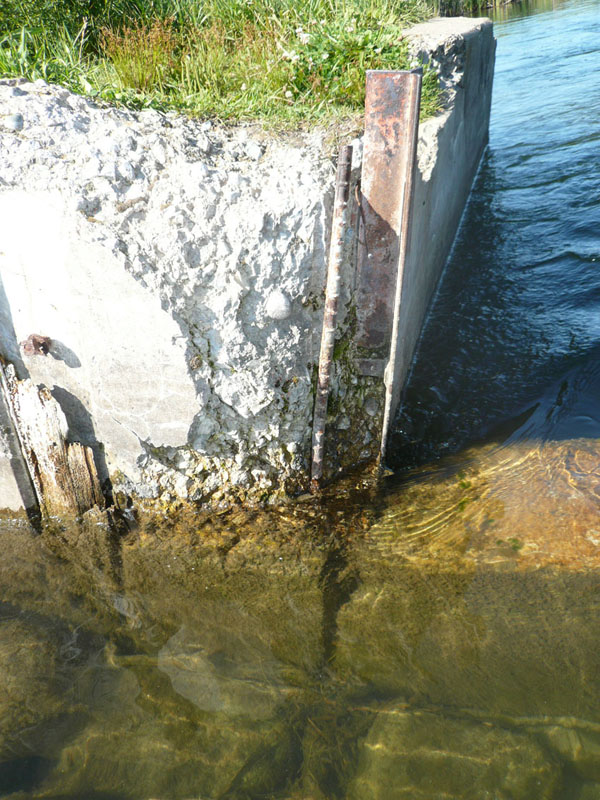 PGOLID has been working with the DNR to have the Pelican Lake Dam repaired. See the attached pictures for a better understanding of the problem. This has been a very slow process and the timeline goes something like this.
PGOLID has been working with the DNR to have the Pelican Lake Dam repaired. See the attached pictures for a better understanding of the problem. This has been a very slow process and the timeline goes something like this.
In the summer of 2003, the center island of the dam washed out and the water level of Pelican Lake started to drop quite rapidly. In the fall of 2003, a steel plate was placed in the washout with rocks and sand filled in front of it as a temporary repair. It was determined at that point, that the DNR controlled the dam and was responsible for any repairs. In 2005, PGOLID started pressing the issue of repairing the dam with the DNR and in the Fall of 2007, it appeared the DNR was going to do the actual repairs to the dam. Unfortunately, the DNR thought a repair meant throwing a few bags of Quikrete in front of the temporary repair which is what they did in the winter of 2007/2008.
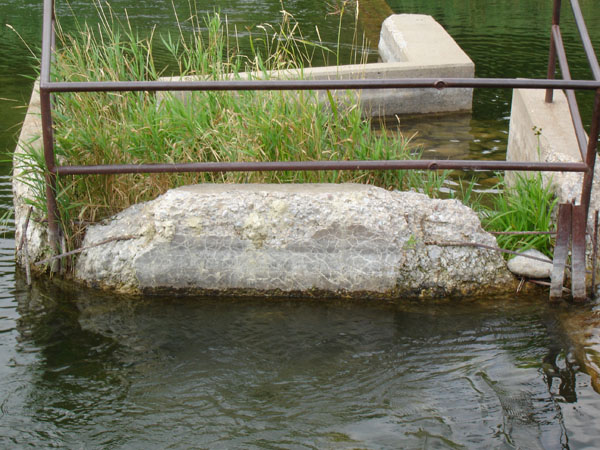 In 2008, more meetings with the DNR occurred and a consensus was reached, that the dam should be repaired before it washes out again, as the cost would be much higher if the dam washed out before repairs could be executed. Paul Diederich of Industrial Builders provided a budget bid of $250,000 to make those repairs. It was then learned that 3 years earlier, the DNR also received a budget bid for the repairs of $200,000. In the Fall of 2008, conversations with theDNR State director of the Waters Division revealed the budget for repairing dams for 2008 was $2M. There were 100 dams on that list though the Pelican Lake dam not is not currently on the top 20 list. The New London Dam is #1 at $2M and Brunson State Park is #2 at $8M which adds up to not-enough-money. More conversations with DNR and our state representatives concluded that some sort of cost sharing between the DNR and PGOILD may be the only alternative to accomplishing the repairs. Talks are continuing along those lines. This is clearly a slow process with steps forward and steps backward.
In 2008, more meetings with the DNR occurred and a consensus was reached, that the dam should be repaired before it washes out again, as the cost would be much higher if the dam washed out before repairs could be executed. Paul Diederich of Industrial Builders provided a budget bid of $250,000 to make those repairs. It was then learned that 3 years earlier, the DNR also received a budget bid for the repairs of $200,000. In the Fall of 2008, conversations with theDNR State director of the Waters Division revealed the budget for repairing dams for 2008 was $2M. There were 100 dams on that list though the Pelican Lake dam not is not currently on the top 20 list. The New London Dam is #1 at $2M and Brunson State Park is #2 at $8M which adds up to not-enough-money. More conversations with DNR and our state representatives concluded that some sort of cost sharing between the DNR and PGOILD may be the only alternative to accomplishing the repairs. Talks are continuing along those lines. This is clearly a slow process with steps forward and steps backward.
At this point it’s unclear where it will all end up, but as more progress is made, updates will be available. If you have questions, contact Jeff Peltier as he has been taking the lead in this process.
Weed Rollers require a DNR permit
It’s been reported that the DNR went around Pelican Lake and found about 20 Weed Rollers or similar type equipment that didn’t have proper permits. The fine they issue for that is $250 and the permit costs $35, so it makes sense to get a permit first. You can download the permit here: http://files.dnr.state.mn.us/assistance/backyard/shorelandmgmt/apg/apmapp.pdf
E-coli alert for Bob Creek
PGOLID has done some rain event sampling of the water at Bob Creek as it enters the west end of Pelican Lake this summer. This has been a concern because high levels of E-coli bacteria have been found there in the past. During these events the level has been found to consistently be above the standard of 126 MPN/100ml which the state of Minnesota considers not safe for swimming. To minimize any risk, it is suggested that you have your children or grandchildren avoid playing in or adjacent to the creek for a 24 hour period after a rain event until a remedy can be put in place to improve the situation.
PGOLID monitors Flowering Rush
This in an invasive aquatic plant that is currently in Detroit Lakes, Lake Sally, and Melissa, but stops at Buck’s Mill. PGOLID is working with the Pelican River Water Shed and the DNR on a program to reduce or eliminate Flowering Rush along with regular trips down the river to monitor the situation. Click HERE for a description of the plant.
Safe Ice recommendations
The DNR recommends 4 inches for ice fishing, 5 inches for a snowmobile or ATV, 8 to 12 inches for a car or small pickup, and 12 to 15 inches for a medium truck. Considering the recent conditions, ice that may be thick enough might not be of high enough quality to hold.
PGOLID Lake Management Plan is now on the web!
The PGOLID Lake Management Plan is a comprehensive report from over a decade of data collection and effort from many organizations. It is a summary of water quality data along with information and background about the surrounding area, demographics and land use. Moriya Rufer, our Water Resource Coordinator, has done an excellent job of organizing this into easy to navigate segments so you can quickly find particular items of interest. Go tohttp://pgolid.org/LMP/main.htm to view the information.
Buckthorn is designated as a restricted noxious weed in Minnesota
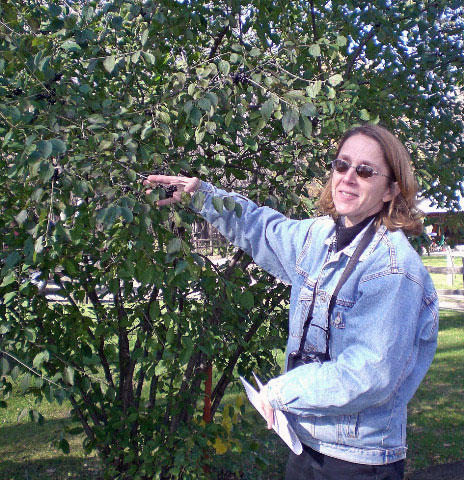 Linda Ekola, a shoreline habitat specialist from the DNR, doing an onsite visit at one of the cottages in-line to possibly receive funds from the Shoreline Habitat Restoration Grant program.
Linda Ekola, a shoreline habitat specialist from the DNR, doing an onsite visit at one of the cottages in-line to possibly receive funds from the Shoreline Habitat Restoration Grant program.
The Shoreline Habitat Restoration Grant program is to help with shoreline restoration, specifically to: restore native shoreline vegetation across the state, expand the diversity and abundance of native aquatic and shoreline plants; improve and protect the quality of shoreline habitat; enhance and protect water quality; raise awareness of the value of native shoreline and aquatic vegetation.
While there, Linda became aware of Buckthorn growing on this property and the neighbors. The buckthorn is designated as a restricted noxious weed in Minnesota. Fall is the easiest time to identify buckthorn. The leaves of buckthorns do not change color until late in the fall, after most other trees have changed. The berries usually stay on the branches until March and are widely dispersed by birds. Once established, these species aggressively invade natural areas and form dense thickets displacing native species. They leaf out very early in the growing season and keep their leaves late into the fall helping to shade out native trees, shrubs and wildflowers. These branches have numerous thorns. The side branches have short terminal spurs, or thorns, which are literally a pain if you try to remove the plant.
Linda is encouraging PLPOA members to read up on the Buckthorn and do all they can to eradicate this invasive plant. To read more about it and what you can do to remove it please go to:
http://www.dnr.state.mn.us/invasives/terrestrialplants/woody/buckthorn/index.htm
The University of Minnesota is doing research on the control of Curlyleaf Pondweed
To read a progress report on their efforts, follow this link.http://www.cfans.umn.edu/solutions/water1.htm
Take steps now to protect your septic system from freezing
By VALERIE PRAX, University of Minnesota Extension
Common reasons systems freeze are lack of snow cover, cold temps
Low snowfall amounts can mean potential danger for your septic system. For the last few winters, we have had a pattern of sub-zero weather arriving before major snowfall. Remember last winter? We did not get significant snowfall until March.
PGOLID has put together an aquatic plant guide.
For a better understanding of different weed and algae species and which are considered Invasive , click HERE.
This is a helpful link to the DNR page for permit requirements to control weeds: http://www.dnr.state.mn.us/permits/water/needpermit.html.
There have been a lot of questions about spraying for the Forest Tent Caterpillar.
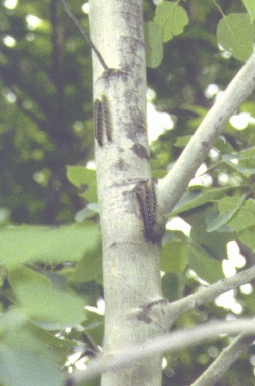 We are now past the window for the need to spray this year, but still need to be alert in the next couple of years as the cycle is not exactly 7 years, but a range of 6 to 10 years. Many of the sightings this year were not the species of caterpillar we were looking for, so here is picture to help with identification. Note the white or light colored dots on the back. Also the Forest Tent Caterpillar does not form spider-like webs like other tent caterpillars.
We are now past the window for the need to spray this year, but still need to be alert in the next couple of years as the cycle is not exactly 7 years, but a range of 6 to 10 years. Many of the sightings this year were not the species of caterpillar we were looking for, so here is picture to help with identification. Note the white or light colored dots on the back. Also the Forest Tent Caterpillar does not form spider-like webs like other tent caterpillars.
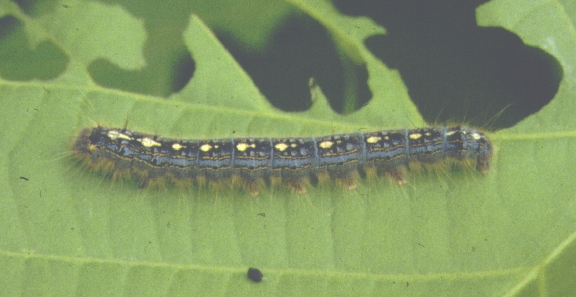
NOTICE TO DUNN TOWNSHIP RESIDENTS
*TOWNSHIP RULES REGARDING ROAD RIGHTS-OF-WAY*
It is unlawful to place any debris including leaves, branches, compost, refuse, etc. in the road right-of-way. It is a misdemeanor to: “Obstruct any highway”, “obstruct any ditch draining any highway” Minn.Statute § 160.27, subd. 5.We would also ask that boats, trailers, etc., not be parked in cul-de-sacs so that they can be used for their intended purpose
The PGOILD Septic inspection report is now complete.
There is a lot of informative and educational material that can help preserve our lake, so be sure to read it!!
